|
My model railroad crosses the Mississippi River. And to show a more complete story, I needed some river traffic.
In 2015, we vacationed in Red Wing, Minnesota, and that's where I saw Lil Charley.
|
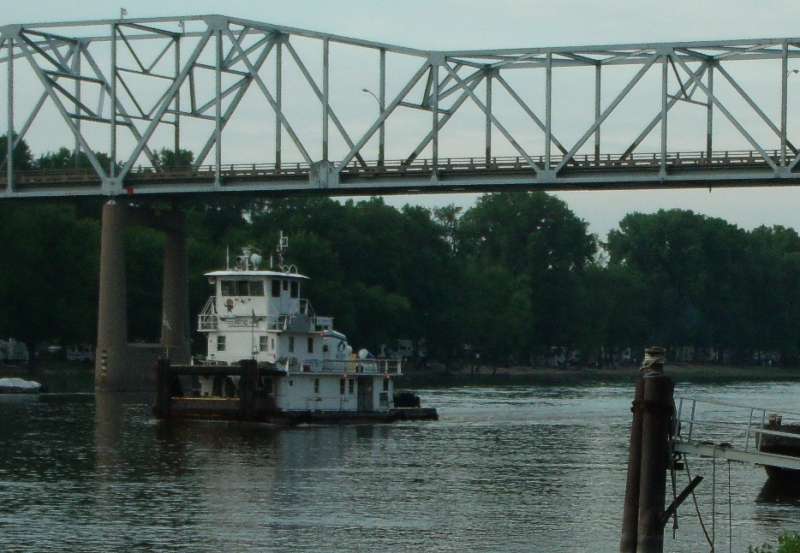
|
I took a broadside picture and printed it to HO scale, and then cut it into pieces for each deck. Each level is a block of wood, with a cardboard deck in between them. I glued the pictures to the wood blocks, and I won't show a view with more detail than this, the result is crude and just a beginning. I didn't have a picture of the right side, so I just printed a mirror image of the left side and glued it on, even the words are in reverse. I call it a 3-foot model, don't look at it closer than that. It's enough to tell my stories on the river and model railroad. There's no handrails, winches, hausers, timberheads, lights, stairs, ladders, radar antenna bar, steering pole, wind flags, etc. It is a waterline model, it sits on my plastic water sheet. |
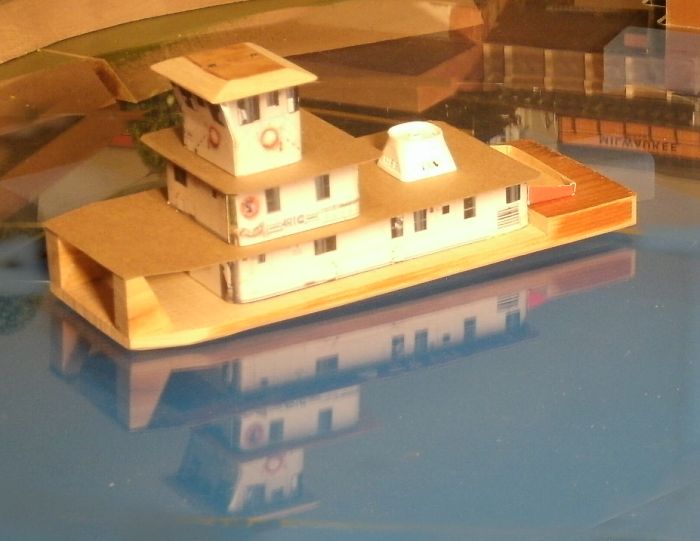
Here is it waiting by shore below my Miller's Dock.
My wife looked at it and noticed right away that the engine room stack was the plastic tip of a window cleaner bottle;
It has 'ON' and 'OFF' molded in it. But it was convenient and faster than building the twin stacks of the real boat.
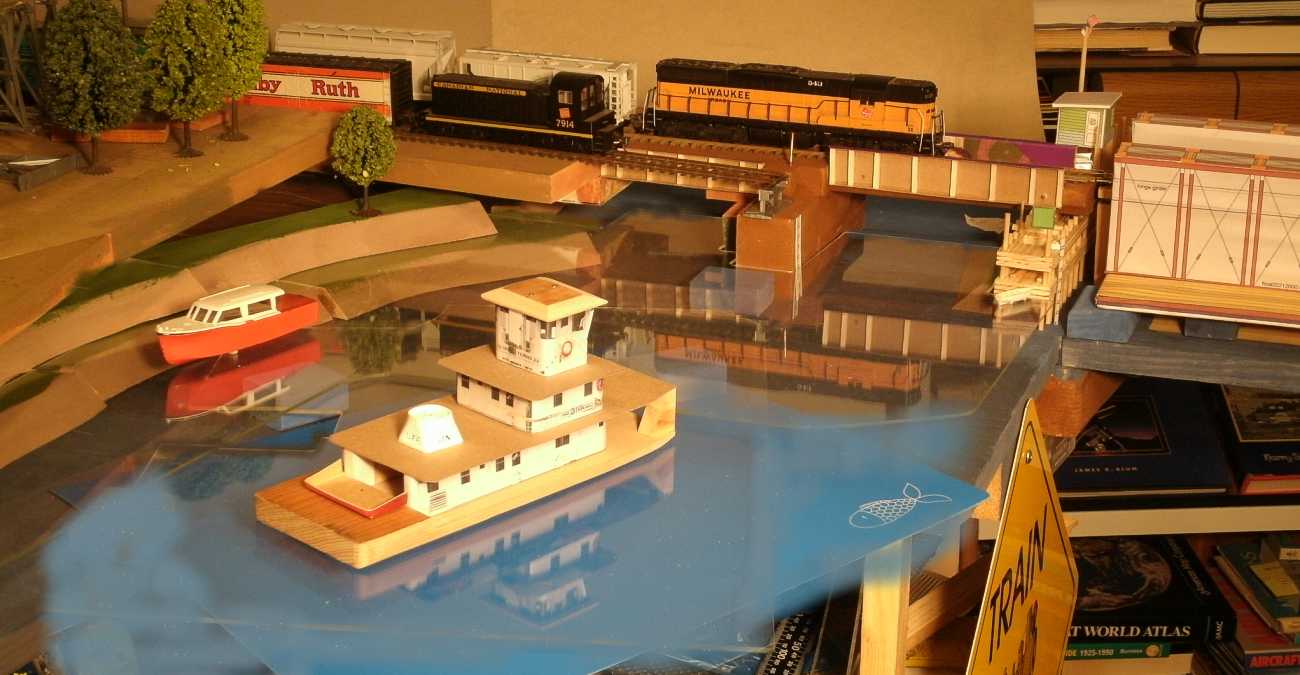
|
So, I am trying to simulate the river traffic as shown on this 1961 postcard at the floating swing pontoon drawbridge of the Milwaukee Road by Marquette, Iowa. (never mind that the Lil Charley was built in the 1980's and operates 150 miles north of my model railroad location) |
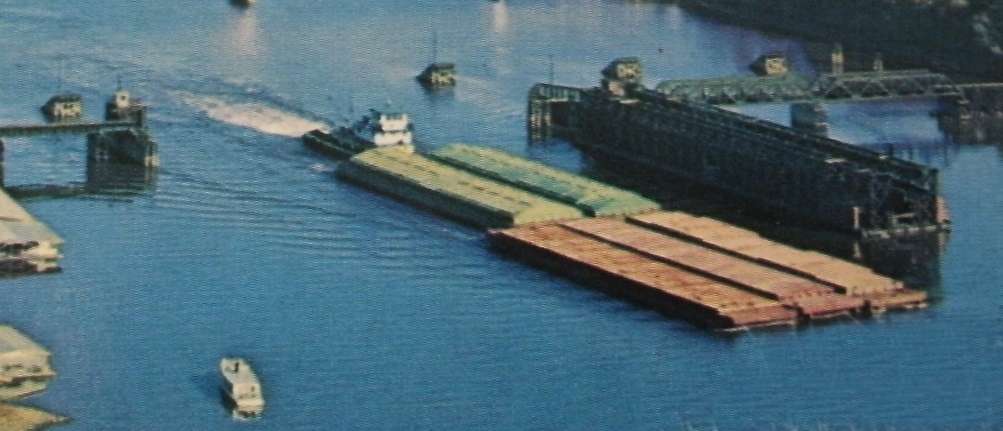
.
|
This is an overall view of the model river crossing with the drawbridge swung open. I started copying and cloning the river to fill in the 'gaps' around the blue painted plywood 'river' that is under the barges. The laundry cart wheels are visible by the floor, and a tripod props up one end of a river extension board. I could have helped the cloning by putting some green trees and river bank on a picture on that old silver projection screen in the back, which hides the book shelf. |
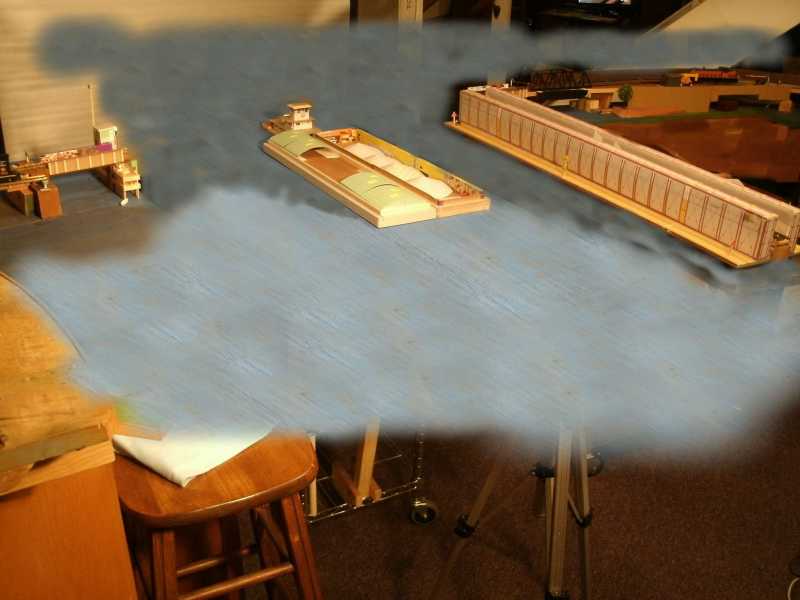
| And when I crop off the rest of the room, |
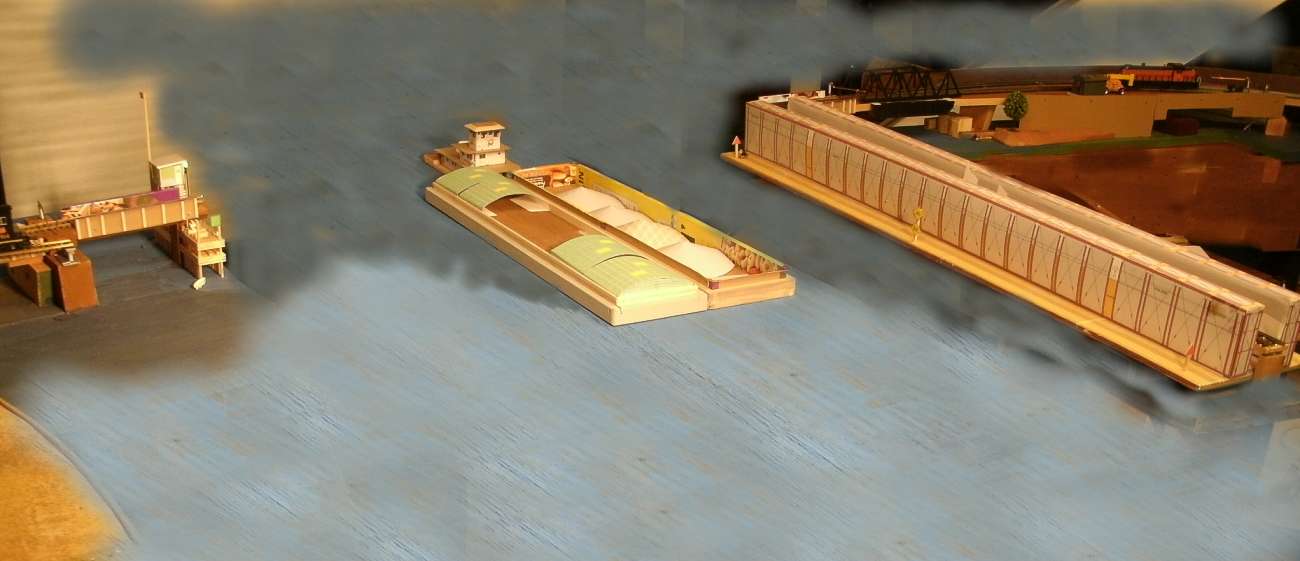
|
This up-bound view has some potential, there's less background needed. I see I need to install the piling of the hinge pier on the far side, that would help to fill the space.
I have the camera backed in to a corner to see this scene. |
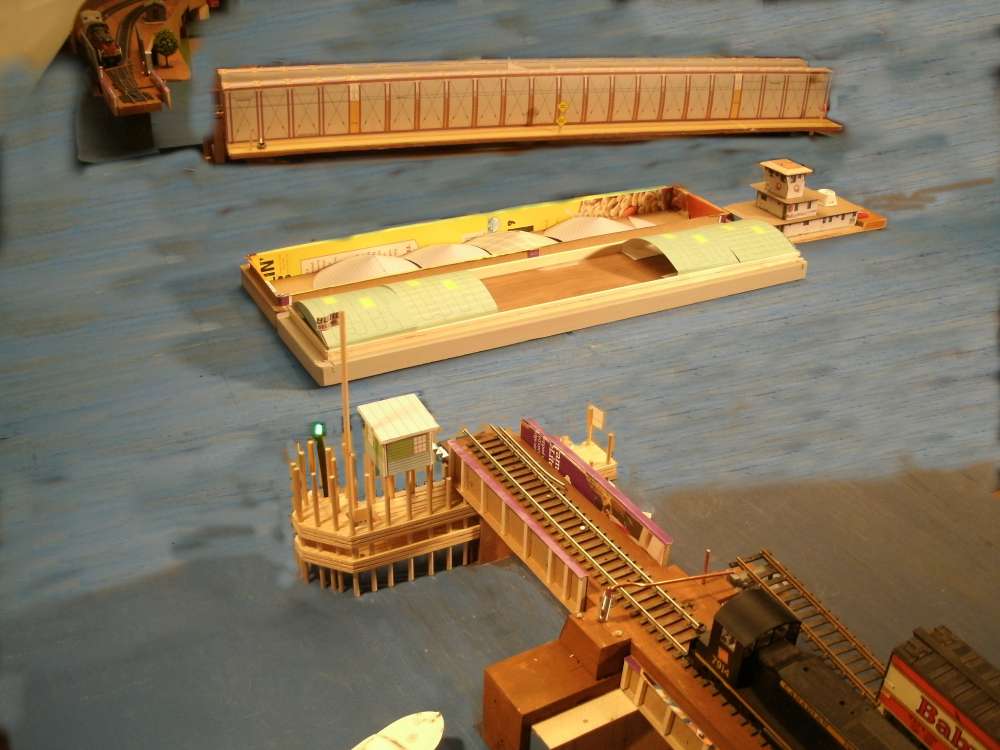
|
I had to take some short cuts when building the barges. Real ones are 35 feet wide and 200 long. That's 5 inches by 27-1/2 inches in HO scale. Too long to dock by my model railroad. So, I made them 22 inches long. One is glued from sticks and cardboard, you can see the cereal advertising inside of it. One is cut from a 3/4 inch pine board. The 22 inches also will let me make a future fleet from construction paper, at two sheets long for each. The covers and limestone cone piles are folded index paper, printed from a computer drafting program |
.
|
And I added some details about the river, such as the bridge clearance gauge boards. It starts at 0 at the top to designate the underside of the bridge, and then you can read the waterline and determine if your boat is too high to fit, before you get to the real squeeze point under the bridge. Some of the real boards on the River go from 0 down to 52 feet under the big bridges. |
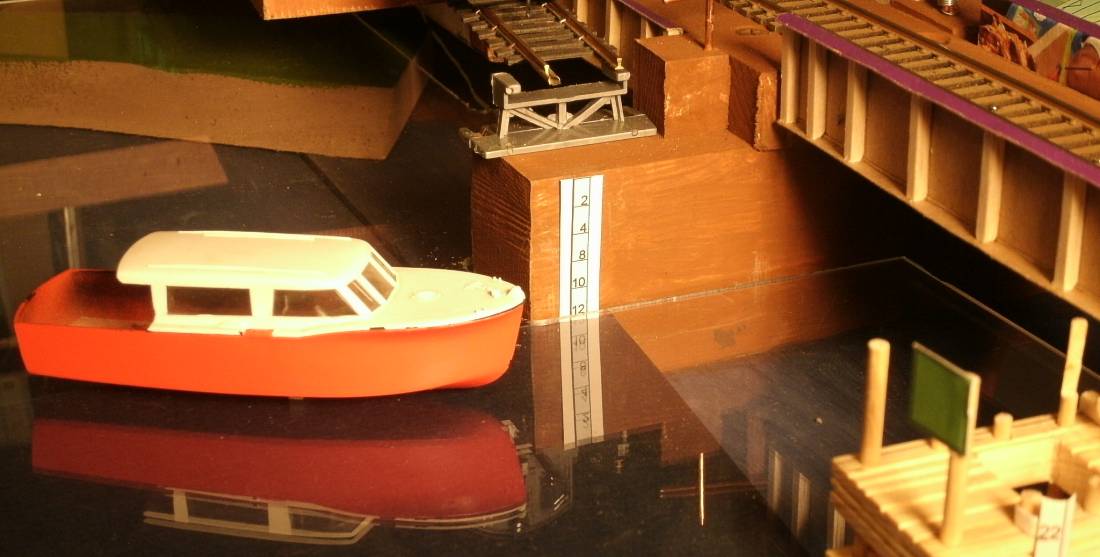
.
|
The reflection at the draw bridge lock pier is from a clear acrylic sheet with a blue plastic chopping board mat under it. I had to be careful while controlling reflections; on one scene I had to remove a clock and picture from the wall. I had framed them out of the viewfinder, but they had subtly snuck into the water reflecting view. |
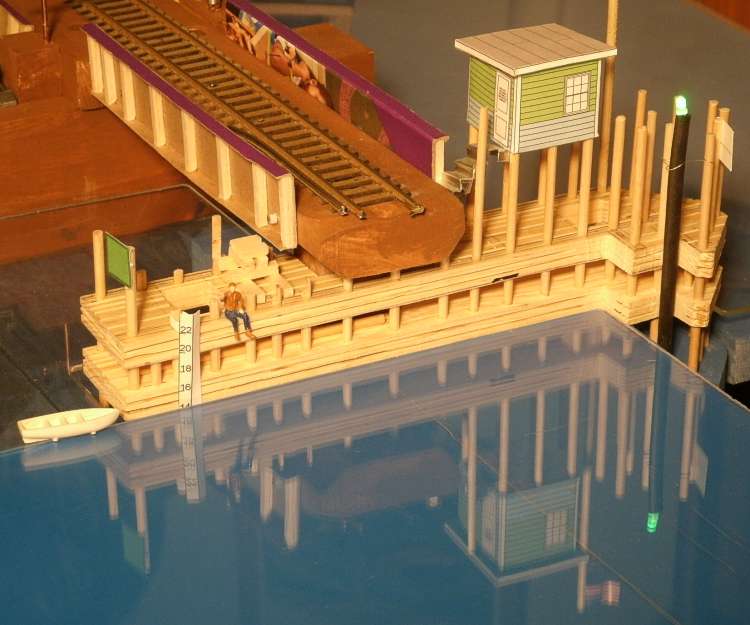
Should I paint clouds on a blue ceiling, to look like real weather that reflects off the water?
How about projecting weather pictures on a white ceiling? And letting that reflect from the water?
I will leave that to imagination.
.
.
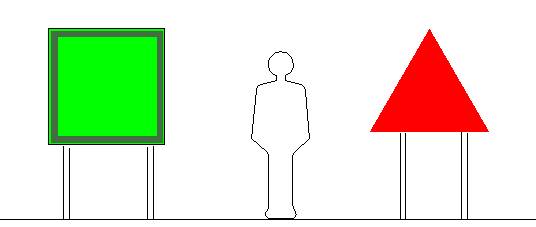 I have to apply some river navigation signs around my model railroad.
I have to apply some river navigation signs around my model railroad.
Every aisle that I walk in is a river or backwater pool. The real River is up to 20 feet deep, or 3 inches on the model railroad. I can sit on a foot stool to put my view at river level, like I'm in a fishing boat and watching trains run along the shore. With more imagination. I have to take more pictures of river banks and print them on paper and glue them to the model railroad faceboard.
Daymark signs are mounted on posts on the shore,
green for the west side of the River, red on the right, if the channel is deep enough that tow boats can navigate close to the shore.
They are 4 feet across.
Not shown, green cylinder can buoys, and red nuns (cone top, like the red triangle) to mark the exact edge of the dredged channel when it is far from shore.
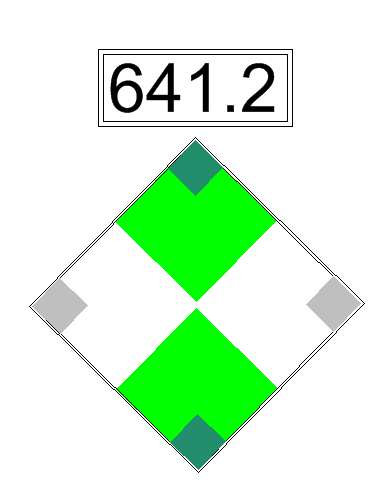 .
.
A daymark information sign,
you need a chart to read the details for river mile 641.2.
That's the river distance from Cairo Illinois.
I estimated the river mile for the Marquette, Iowa, area, but I don't know for sure; I haven't been there in 35 years.
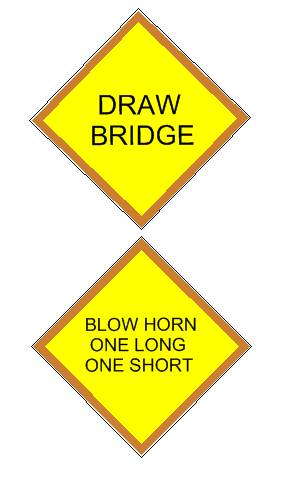 .
.
In the days before river radio, the riverboats would blow a Long and a Short on the whistle or horn.
to get the bridge opened.
If the draw tender heard and understood that, he would reply with the same.
If the draw tender couldn't open the bridge, he replied with 5 Short blasts,
and the boat should reply with the same, and stop before hitting the bridge.
My model railroad is named Bruce's Crossing Railway and Navigation Company.
The Navigation is because the floating bridge is registered as a river boat,
so it has a legal right to be on the river, just like all boats.
And I have noticed a problem that I have seen on the river, sometimes the railroad and river navigation signal lights can be close together and can get confusing after dark.
I might try some more photography and manipulation to create river and railroad scenes.
In the meantime, I will use my imagination to fill in the scenery.
This is what it looks like 6 months later, when it is nearly done:
Floating Pontoon Swing Drawbridge on my Milwaukee Road model train layout
Here are Links to previous RR pages,
Modeling the Milwaukee Road Pontoon Swing Draw Bridges showing how my model railroad bridges looked 2 months ago.
Great Spirit Bluff Falcons Cliff View shows Spirit Bluff Falcons with a You Tube camera on the cliff, and sometimes you can see the river traffic, and sometimes they move the camera to see barges going through Lock and Dam Number 7 by La Crescent, Minnesota. Sometimes you can see the Canadian Pacific trains, too. And they might show some great sun rises and moon rises over the wide Mississippi River.
You can search for many river tow boats by using Dicks tow boat gallery
And for riverboats (paddle boats), try Dicks Paddle boat gallery
. . . . . to My Main Index Page on the TrainWeb site.
This page was wrote in June 2020.